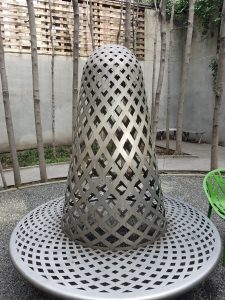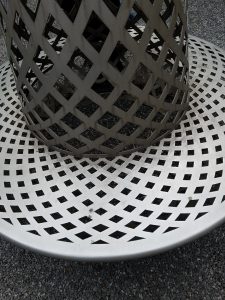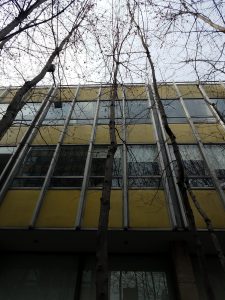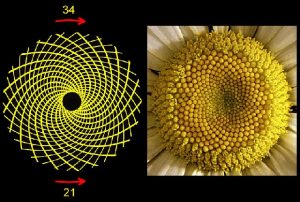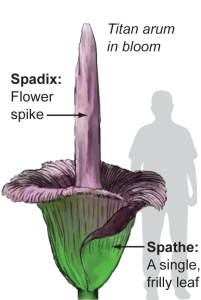Charles Ta
Professor Rory O’Dea
History of Modern and Contemporary Art
April 21, 2018
An Analysis on Martin Puryear’s and Michael van Valkenburgh’s
Untitled (1997), in the New School Vera List Courtyard.
Made of stainless steel and yet emblematic of both simple, beauteous design and harmony between nature and technology (“organic geometry”), Martin Puryear’s and Michael van Valkenburgh Untitled (1997), stands proud as a site-specific “environmental art” piece that combines and encapsulates Puryear’s quasi-Minimalist, geometric artmaking philosophy with its use of the mathematical Fibonacci sequence/ Golden Ratio, and Valkenburgh’s experiential philosophy regarding the space an art piece occupies, and how knowledge can be derived from it being experienced rather than merely visualized. Situated amidst a circular arrangement of maple trees planted near or on chaotic brown soil, and on top of a small mound of humble granite and other stones, all while surrounded in its larger environment by the walls of Lang College’s buildings, Untitled (1997) is a paragon of the union between man-made artificial constructs and the elements of the natural environment that they are both informed and inspired by. In addition, it informs the New School’s commitment to sustainable architecture and art, its core values of eco-friendly and environmental preservation, and its role as one of New York’s “greenest” campuses. It is multifaceted in its ability to elicit in viewers different experiences of being around it depending on the viewer’s locale (near the metal structure, or far away from it behind the maple trees).
Despite the fact that most of Puryear’s installation work may be considered “Minimalist”, or the very least purely “Formalist” in nature, Puryear denies these monikers to describe his art and instead professes himself as an independent artist without a movement, whose works are “combinations of the organic and the geometric”. Valkenburgh, by the same token, is a landscape architect rather than an artist, whose works, according to landscape theorist Anita Berrizbeitia, “are based on the conviction that not only can the power of nature and the power of the man-made coexist, but they are the better for doing so”. Furthermore, James Corner, another landscape architect, writes in his book Design with the Land: Landscape Architecture of Michael Van Valkenburgh, that Valkenburgh’s work “demonstrates that the knowledge of a place derives more deeply through experience of material, time, and event, than through visuality alone, and that landscape experience is fuller and more profound when it accrues through inhabitation than through the immediacy of the image or the objectification of the new”. It could be said that Puryear’s and Valkenbergh’s Untitled (1997), then, is a blend between the organic geometricity of Puryear, and the experiential profundity of Valkenburgh. It is the type of site-specific art piece that must be experienced and viewed at from different angles as opposed to merely seen through an intrusive medium or screen (a la earthworks like Robert Smithson’s Spiral Jetty), leading to profound ideas about the relational dynamics of technology and nature, and, ultimately, how we as humans relate to the world around us.
When I first viewed Untitled (1997), I immediately found myself immersed in the experience of being in the presence of the piece, and from that, derived its philosophical and theoretical implications, rather than the other way around. Spending time in the soothing, harmonious environment of the installation and the trees around it, while also listening to the sounds of the wind passing through the Vera List Courtyard and betwixt the tall trees, the chirping of nearby birds, and the idle chatter of nearby university students, allowed me to make a few keen observations about the strategic placement of Untitled (1997), and the way I interacted with it depending on my perspective from near the piece (inside looking out to the trees) vs. far away from the piece (outside looking in). These observations led me to continuously reframe the site-specific piece under new contexts and that allowed me to tap into its deeper significance in the space of the Vera List Courtyard, as well as in the invisible space found within ourselves, since it addresses our relation to the environment, and it to us.
For starters, since Untitled (1997) embodies human artificiality and order, and it is placed in the middle of an almost ritualistic circle of trees embodying chaos and the unrestrained wilderness of the natural environment, I first imagined the site-specific piece as an idol being worshipped or revered by the trees, eliciting in my mind the power dynamics between humanity’s technological achievements and nature— the former, in this day and age, seemingly trying to supersede the latter. Inspecting the piece more, the inevitability of the circular ledge at the base of Untitled (1997) led me to the conclusion that, in terms of function, the installation was, since its very inception, meant to be sat on, placing the viewer in the position of Untitled (1997) as a entity deserving of reverence from nature. Valkenburgh’s landscape architecture firm, Michael Van Valkenburgh Associates, Inc., elaborates on this idea of sitting on its website, stating that, “set in a small courtyard that links two buildings with entrances at different elevations, [this piece] enables and dignifies the simple acts of sitting, gathering, and walking from one level to another”.
Looking from the outside inward, I found myself in the spatial position of the trees, looking down at the piece or meeting it at eye level as if to acknowledge the majestic wonder of technology, which produced this metallic steel piece. At the same time, I also easily interpreted the tallness of the trees as a factor to the interpretation of the installation in question, since imagining myself as being one of the tall maples staring down at Untitled (1997) with almost judgmental, condemning eyes led me to conclude that the trees were not only revering the art piece, but also paradoxically trapping, cornering, vilifying, and isolating it with discrimination and an inflated sense of superiority. The art piece, in short, felt tiny, powerless, and insignificant in the view of the trees, while approximating the height of an average human from a person’s perspective.
Going through the trees, and sitting on Untitled (1997), and looking upwards from the inside outward, I noticed that the maple trees seemed to meet at a single vanishing point/ region amidst all the branches, encapsulating and enveloping the art installation as if to protect it (in reference to its idolization), and at the same time, as if to prevent it from reaching their heights. I was forced to reconsider and re-evaluate my previous interpretations of Untitled (1997) in relation to the dynamic between technology and nature— humanity and the environment. I asked myself: was this piece evoking the notion of humanity’s technological superiority over nature (eliciting related ideas of Cubism, Modernism, Constructivism, Futurism, etc), the idea of sublime nature’s eternal dominion over the human race, no matter how much it strives to surpass its glorious perfection (engendering ideas of pure Romanticism), or possibly commenting on the harmonious union and need of balance of both (evoking the earthworks, and the post-modernist environmental art of the last several decades)?
Because Untitled (1997) seemed to contradict itself with the reversal of roles upon stepping inside the circle of trees and stepping outside of it (the art piece as idol, but the trees also as natural forms to be worshipped from the perspective of someone sitting), I concluded experientially that Untitled (1997) was actively, by its presence, questioning our intrinsic relationship to nature as beings ultimately spawned by nature and the process of evolution over countless eons, without explicitly providing the viewer (or, rather, the experiencer), with definitive answers. The piece itself would not be able to serve its functioning without the Courtyard around it, and vice versa, making Untitled (1997) a piece placed with deliberate, geomantic intention. The university it forms a part of, and represents, holds sustainability and the merging of technology and nature as its core values, with its University Center “[meeting] the USGBC’s LEED Gold standard, making it one of the greenest academic buildings in the country, and in New York in particular”.
Observing Untitled (1997) with greater scrutiny, the shape of the the art installation, its mathematical precision, and its mimicry of various natural forms next caught my attention and deepened my understanding of this piece as a entity that not only questioned humanity’s relation to nature, but actively mimicked nature itself in an attempt to bring artificiality and organicity together as one whole. The semi-phallic form of Untitled (1997) evoked for me the notion that it is almost trying to rise up and approach the height of the trees around it, but is unable to, and is captured in a perpetual moment of “reaching” for the sky. To me, it symbolized humanity’s continual Sisyphean struggle against the adversity of the natural world and of things seemingly beyond the reach of technology and artificiality.
Untitled (1997), I noticed upon further analysis, seemed in addition to not only desire to reach the heights of nature in a physical sense, but in a mathematical and aesthetic sense as well. Sprouting and budding out of the ground like a sort of metallic flower about to bloom, I immediately compared the interlocking spiraling steel parts at its base (see close-up) to the visual-mathematical representations of the Golden Ratio/ Fibonacci sequence found at the seedheads of many flowers (like sunflowers), and likened its prominent tubular apparatus “growing” upwards to the spadix of the Titan Arum plant or the “corpse flower”— the world’s tallest flowering plant. With these insights, I concluded that Untitled (1997) cements the idea of humanity trying to approach the wonder of nature by mimicking its beauty, and taking inspiration from it to create analogous artificial structures. Puryear and Valkenburgh clearly had intentions when creating this art installation, based on the theory and philosophical meaning behind their works, and they successfully communicated their ideas by combining their views together and realizing them in one singular monolith.
Middle image acquired from “Jesuit Roundup”, Right image from “Chicago Tribune”:
https://www.jesuitroundup.org/news/academics/math/1123-go-fibonacci-day-at-jesuit/
http://www.chicagotribune.com/lifestyles/home/ct-corpse-flower-bloom-htmlstory.html
To conclude, Puryear and Valkenburgh’s Untitled (1997) embodies the merger between technology and nature and the philosophies of both artists’ made manifest in their works, informs and makes me as a viewer question humanity’s relation to the environment— whether it is hostile and invasive, anthropocentric and reverential, or a harmonious balance between the two, reinforces the New School’s commitment to sustainability, conceptually mimics nature in its mathematical precision while contrasting it equally with its choice of industrial material (steel), and overall exists on the behalf of recent environmental art movements while nodding to the reductionist Minimalists due to its sleek simplicity. Although some might merely see this piece as meaningless, I found that Untitled (1997) possessed meaning not through itself, but through the space around it that it defines, contextualizes, and imbues with significance through the experience of being there. It successfully qualifies as a site-specific piece because it can only be interpreted and seen for the masterpiece it is in the context of the space it was designed for.
